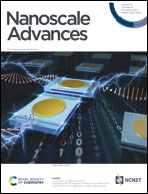Optical humidity sensors based on lead-free Cu-based perovskite nanomaterials
Abstract
Organometallic halide perovskite materials possess unique and tunable optical properties with a wide range of optoelectronic applications. However, these materials suffer from humidity-driven degradation in ambient atmospheres. In this paper we investigate stable copper-based perovskite nanocrystals for potential use in humidity sensors, specifically examining their unique humidity-dependent optical properties and reversibility. We controlled stoichiometric ratios of Cu-based perovskites and demonstrated that (methylammonium)2CuBr4 nanocrystals showed excellent reversible physisorption of water molecules. These perovskite nanocrystals exhibited reversible hydro-optical properties, including transparency changes in response to variations in relative humidity under ambient conditions. The perovskite nanomaterial humidity sensor was highly reliable and stable, with a linear correlation in a relative humidity range of 7% to 98%. Accordingly, the lead-free Cu-based perovskite materials developed herein have the potential to be employed as real-time, self-consistent humidity sensors.



 Please wait while we load your content...
Please wait while we load your content...